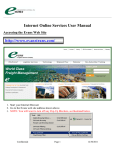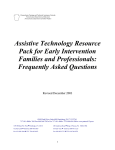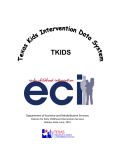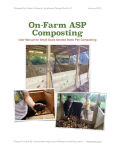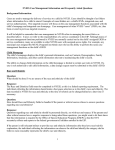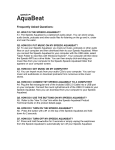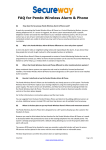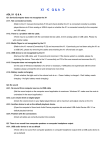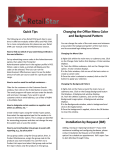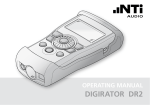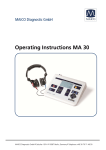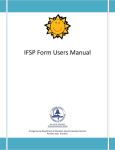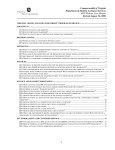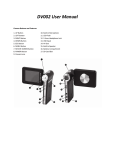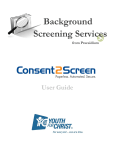Download TKIDS 4.5 Release Webinar – 10/12/10
Transcript
TKIDS 4.5 Release Webinar – 10/12/10 General Q1. Will this Power Point be published? A1. Yes. We will send it out after the webinar and put it up with the archived webinar. Q2. Is anything going to be discussed beyond the content of the Power Point? A2. No, the Power Point identified all that would be covered in the webinar. The stated objectives included review of: System and data entry changes in the TKIDS 4.5 release Changes to the TRAD Transition Report Modifications to the TKIDS User Manual Each ECI program must read and become familiar with the TKIDS release notes, TRAD change description, and the TKIDS User Manual. IFSP and Screenings Q3. Wouldn’t you always do a revision IFSP to designate the newly assigned service coordinator? A3. Sometimes a service coordinator must begin working with a transferring family before the IFSP revision can be completed. We are assuming this is in reference to Standard 8.1.2 which says: Upon receiving a transfer referral from another ECI contractor in Texas, the receiving contractor must designate a service coordinator; and contact the family to o verify the planned move date to the service area, o deliver services according to the existing IFSP, and o schedule an IFSP meeting to make necessary changes. Additionally, the TKIDS manual requires that the receiving program enter The IFSP Type, IFSP Meeting Date, Family Signed Date, and planned services data indicated on the IFSP from the transferring program. The program must “designate” a service coordinator to contact the family and begin working with them on any necessary details regarding the transfer. The service coordinator may need to be in contact with the family several times before the IFSP can be revised. At the scheduled IFSP meeting, an IFSP revision must be completed to add the name of the designated service coordinator, even if there are no changes to the services. 1 Q4. If the hearing and vision screeners are done at the initial evaluation, does that make them part of the pre-enrollment? A4. Yes. Transfers Q5. Is the date to initiate services the date of phone contact to schedule, or date of F/F visit to amend plan and/or deliver service? A5. As stated in the TKIDS User Manual, Instructions for Transfers (Chapter 4), the date of the first face-to-face contact must be entered. For transferring cases only, the first face-to-face contact may be by telephone. Q6(a). The Exit Outcomes should be going with the child, but when we are obligated to print out the TKIDS case report and send it with the transfer, we are not sending Exit scores. Is this going to create an issue for the receiving program? Q6(b). If we have two weeks to enter Exit Outcomes scores, how does that help/hinder the info on the transferred child regarding case report? Shouldn’t the Exit Outcomes be included in the case report transfer? A6. There is no reason for the exit outcome ratings to be sent on the case report for a child transferring to another program. ECI Standards do require that exit ratings be completed for all children who leave a program (exit or transfer) who have been in services at least six months. The exit rating for a child at the first program is used to address progress made at that program, and is used as the final exit rating if the transfer does not occur. However, that exit rating does not need to be sent to the next program. If a child was enrolled in a program for three months and transfers to another program, the entry ratings would be sent via the previous case report to the new program and an annual outcome rating and/or exit rating would be completed as appropriate. Subsequent outcome ratings cannot be entered without an entry rating, and the entry rating serves as the trigger for the annual and/or exit ratings. 2 Q7(a). So if the previous ECI program enters the services on the IFSP, will those services show up on the TKIDS printout report? Q7(b). Are planned services now on the TKIDS report printout? Q7(c). So is the previous case report going to include all planned services? Q7(d). For transfers, does the receiving program have to re-enter the most recent IFSP from the program sending it? Is it not possible to have an electronic release of that previous IFSP to avoid entry duplication and possible data entry error? A7. For transfers, the receiving program must re-enter the most recent IFSP from the transferring program. The Previous Case Report will not include the planned services from the transferring program. ECI Standard 8.1.1 requires that the transferring contractor provide the complete, current IFSP to the receiving program. Q8. What if the transferring department is out of state and the printout is not available? A8. TKIDS is a Texas database only. There will not be printouts from other states. Q9. When we put pending on a screening, will that show up on the Previous Case Report? A9. If a program indicates “pending” for a screening, it will show up in the Case Report. If the previous program indicates “pending” for a screening, it will show up in the Previous Case Report. Q10. So we can provide visits prior to the IFSP review being completed by the new program? A10. Yes, after the child’s current IFSP has been entered into TKIDS. Q11. Are there any plans to change the format so that data transfers with the child from one program to the next without having to re-enter it? A11. At this time, the identifying information about the child and the family automatically transfers with the child. DARS ECI is currently looking at additional TKIDS modifications for data to transfer with the child. 3 Q12: For transfers, the webinar said “enter the most recent IFSP from the transferring contractor, including planned services.” When you refer to the most recent, are you wanting the most recent Initial or Annual, or the most recent revision? A12: As stated in ECI Standards, Chapter 8 – Transfers, the transferring contractor must provide to the receiving contractor with the complete, current IFSP, whether it is the Initial, Annual or most recent revision. Transition Q13. When will we be given guidance regarding “potential eligibility?” A13. Guidance regarding potential eligibility is provided with the documents that accompany the Transition TA change module. Those documents can be accessed on the ECI Extranet. Q14. When should the decision for “potentially eligible” be made by the team? A14. NECTAC has provided a timeline flow chart that suggests that the decision should be made when the child is between 24 and 30 months. It must be determined no later than 90 days before the 3rd birthday so that the notification to the LEA can occur on time. Q15. What determines that a child is potentially eligible? A15. The IFSP team must determine this based on their knowledge of the school districts they work with. Q16. If we enter “No” into TKIDS when we know a child will not qualify for LEA services as we are in the process of transitioning, are these children taken out of the TKIDS formula related to our transition indicator and report? We ask because these children will not have any dates in the system or other required information. A16. Children who are not potentially eligible for Part B will not be considered in the transition indicators on notification and the conference. Performance managers will monitor to activities related to transitioning for children not eligible for Part B. 4 Q17. What if a parent decided to opt out of the Part B notification because they changed their mind, but it was after the referral (notification) had already been made and after we had entered the referral (notification) date into TKIDS? When we tried to enter an opt out date, TKIDS would not allow us to. How then do we capture that the parent elected to opt out? A17. Once the notification is sent to Part B, then opting out is no longer an option for the parent. If the notification was not yet sent to Part B, the ECI program could go back into TKIDS, delete the referral (notification) date, and then enter the opt out date. Q18. As it is now required that transition steps be included in every IFSP, regardless of age, I am assuming that the “Date Steps in IFSP” refers to the more specific plan developed at 24 months. Is this correct? A18. Yes. Q19. Is the Part B eligible section equal to what we called the referral previously? A19. Not exactly equal to because of the opt-out policy, but the new Part B Potential Eligibility/Notification section on the Transition page does replace what were formerly the referral sections. Q20. Are we no longer measuring 90 day referral to ISD or entering the date the 90 day referral was made? A20. Referral to ISD is now called notification of potentially eligible. The date of the notification is the date to be entered. Q21. If we make a referral within the 90 day timeline, do we still enter the date or do you do this automatically? A21. Initially with the TKIDS 4.5 release, for cases where there was previously a Referral to Part B Date, the Potentially Eligible field was be set to “Yes,” and the Referral to Part B Date was converted to the Date of Notification to Part B. At this time, any further data entry must be done by the ECI program. 5 Q22(a). I guess I was thinking that the notification to part B was when children turn two years old; it sounds like this is not for that but the 90 day referral to the ISD. Q22(b). Is the date of notification the two- year report date or when they have the referral date? Q22(c). I think people are confused because there is “opt out” language for our notifying the ISD at 2 for child find, and now what was formerly called “declined” referral to Part B is shown as “notification to Part B” (two things with similar language). A22. There are two notifications to Part B. The first is for child find purposes when the child is two years old; this notification date is not entered into TKIDS. The second is the notification for a child who is potentially eligible for Part B; this notification date is entered into TKIDS. Q23. Under the new standards, aren’t we now to hold the transition conference whether or not the ISD shows up? (reason for no conference) A23. Yes, if ECI scheduled the conference and invited the ISD as required, ECI should hold the conference even if the ISD does not show up. If the ISD scheduled the conference but did not show up, the ECI program is responsible for scheduling the conference and inviting the ISD. In this case, if the conference was late, then the Reason for Late or No Conference would be “Part B Program.” Q24. Is it possible to have the Potentially Eligible (Yes/No) field default to “Yes”. A24. This field was not programmed to default to “yes.” The intent is for ECI programs to make a deliberate determination and manually enter it into TKIDS. Q25. Just to confirm, the 90 day referral date is the Date of Notification to Part B? A25. Yes. Q26. On the Transition page in TKIDS, would it be possible to re-order the page to match the way the process occurs? Currently you have the Part B Notification before the Conference. The process of completing these tasks with the child/family is the conference typically occurs before the Notification. A26. The Transition page will not be re-ordered since determination of potential eligibility for Part B and the option to opt out must occur before the conference or the notification. There is no requirement for the conference to occur before the notification. 6 TKIDS - General Q27. What do you mean about chronological order? A27. Regarding the “defect fix” described during the presentation, previously, if a Complete Review (Revision or No Change) was deleted when there was already a later Complete Review entered, TKIDS erroneously removed the Complete Date from the Action. This now works correctly as long as the IFSPs are deleted in reverse chronological order. This means that TKIDS will correctly record the Action as long as any Complete Reviews that were entered are deleted with the latest review being deleted first. Q28. Will a nutrition screening that is due (within 28 days of the IFSP) show up on the action plan from TKIDS? A28. No. There are no Actions generated that relate to screenings. Q29. What planned service type do we choose for inclusion and socialization services? In the past, we used “Other.” A29. Please refer to Appendix A in the contract for the description of service types and providers. If any current IFSPs contain the service type Other, it must be changed to the correct service type during the next IFSP review. For example, Orientation & Mobility should be entered as Vision Services. If you have additional questions, contact your performance manager. 7







